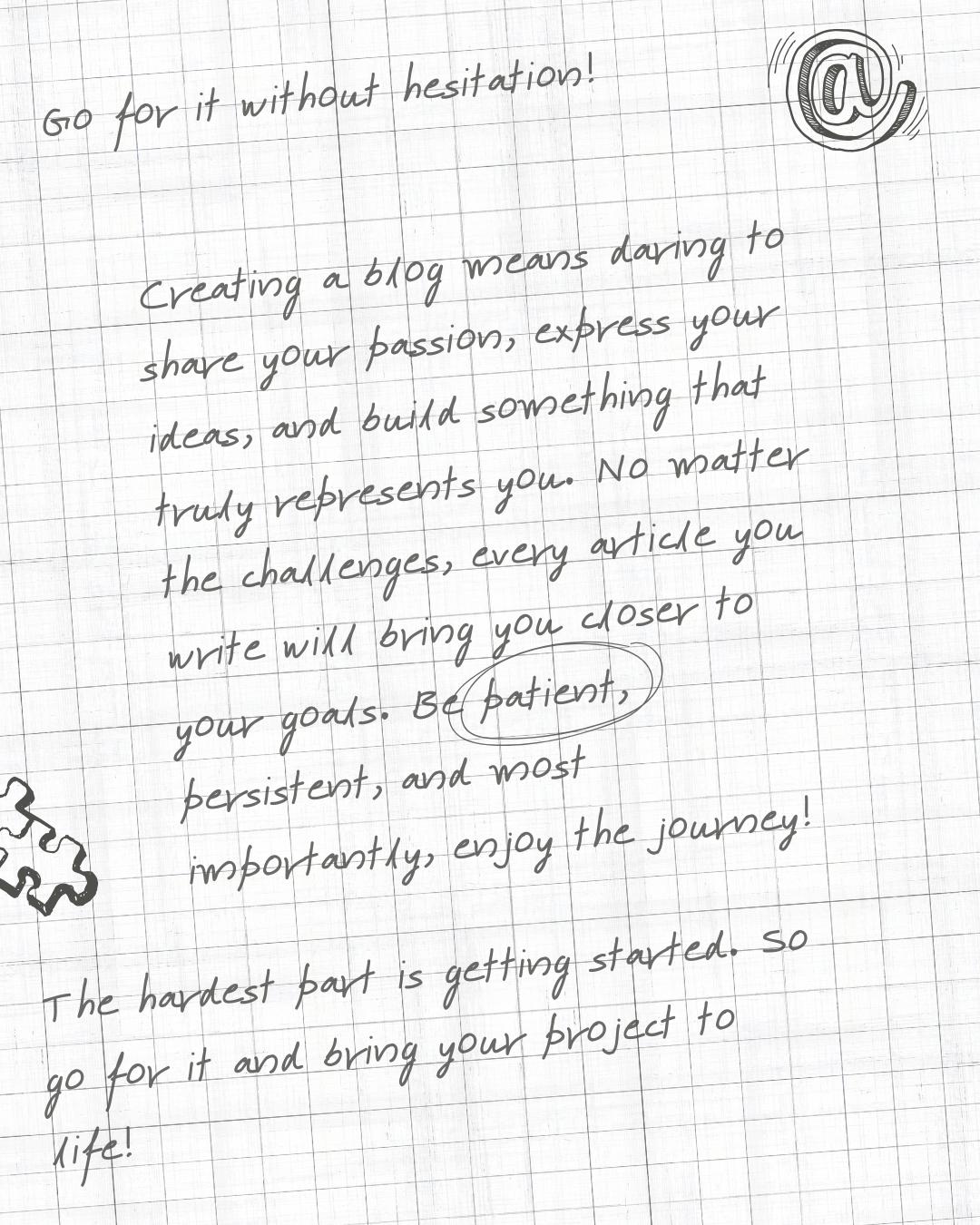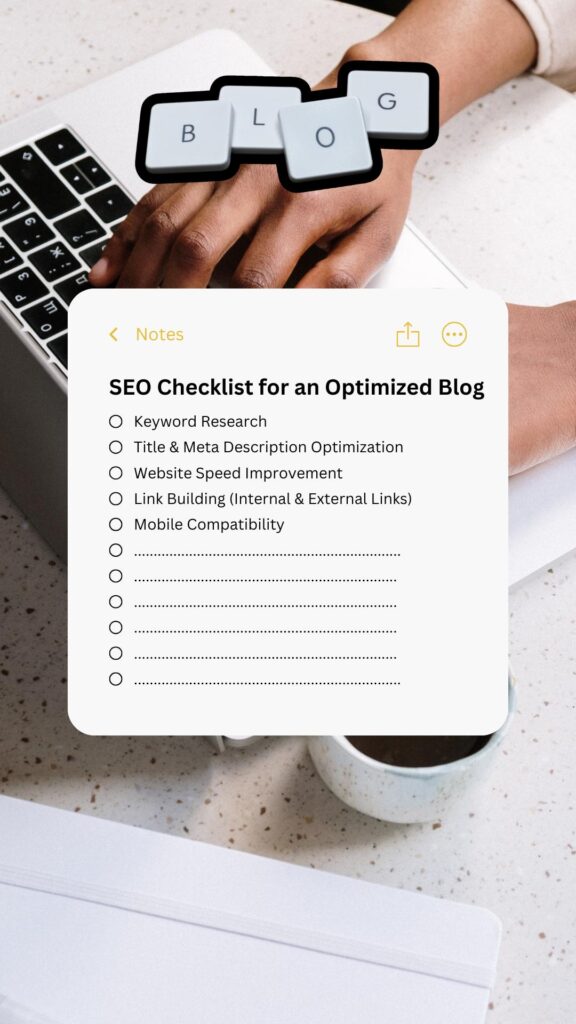Blogging is an exciting way to share your thoughts, expertise, or business with the world. Whether you want to start a personal blog, a niche website, or a monetized blog, this guide will walk you through the entire process. By the end, you’ll have a fully functional blog ready to attract readers and generate income.
Let’s get started!
- 1 Step 1: Choose a niche & define your audience
- 2 Step 2: Pick the right blogging platform
- 3 Step 3: Get a domain name & hosting
- 4 Step 4: Design your blog (themes & branding)
- 5 Step 5: Write your first blog posts
- 6 Step 6: Optimize your blog for SEO
- 7 Step 7: Promote your blog
- 8 Step 8: Monetization Strategies
- 9 Conclusion: Start Your Blog Today!
Step 1: Choose a niche & define your audience
Before setting up a blog, it’s essential to decide what you’ll write about. Choosing the right niche helps attract a targeted audience and makes it easier to grow your blog.
How to choose the perfect niche ?
- Passion & Expertise – Pick a topic you’re passionate about and knowledgeable in.
- Market Demand – Research trending topics using Google Trends, SEMrush, or Ahrefs.
- Monetization Potential – If you want to make money, consider niches with high affiliate marketing potential (e.g., finance, health, tech).
💡 Popular Blogging Niches:
- Personal Development
- Health & Fitness
- Technology & Gadgets
- Finance & Investing
- Travel & Lifestyle
- Food & Recipes
Once you have a niche in mind, define your target audience. Who are they? What problems do they face? Your blog should provide valuable content tailored to their needs.
Step 2: Pick the right blogging platform
Selecting the right blogging platform is a crucial step, as it determines your blog’s flexibility, customization options, and long-term scalability. The ideal platform should be easy to use, SEO-friendly, and allow for future growth.
Top Blogging Platforms
| Platform | Pros | Cons |
|---|---|---|
| WordPress.org (Self-hosted) | ✅ Most flexible and customizable ✅ Access to thousands of themes & plugins ✅ Ideal for monetization (ads, affiliate marketing, selling products) ✅ SEO-friendly with advanced optimization options |
❌ Requires web hosting ❌ Slight learning curve for beginners |
| Blogger | ✅ Free and beginner-friendly ✅ Hosting included (by Google) ✅ Secure and stable |
❌ Limited customization options ❌ Outdated features ❌ Limited monetization opportunities |
| Wix | ✅ Drag-and-drop editor, easy to use ✅ Great for beginners ✅ Hosting included |
❌ Less flexible for advanced SEO ❌ Limited control over performance |
| Squarespace | ✅ Beautiful, professional-looking templates ✅ Smooth, user-friendly interface ✅ Secure and reliable hosting included |
❌ Limited customization options ❌ Requires a paid subscription |
Which blogging platform should you choose?
💡 Our Recommendation: WordPress.org is the best choice for those who want a professional, scalable, and monetizable blog. It provides full customization control, access to powerful plugins, and excellent SEO optimization tools.
If you’re looking for a completely free and easy-to-use option, Blogger could work, but it lacks long-term growth potential.
For quick, no-code website building, Wix and Squarespace offer beautiful designs but are less optimized for SEO and customization.
✅ Verdict: If you’re serious about building and monetizing a blog, invest in WordPress.org with reliable web hosting from the start. 🚀
Step 3: Get a domain name & hosting
Before launching your blog, you need two essential components:
- A Domain Name – This is your blog’s web address (e.g., www.yourblog.com), which visitors will use to find your site.
- Web Hosting – This is the service that stores your website’s files and makes it accessible to users 24/7.
Choosing the Right Domain Name
Your domain name is the foundation of your blog’s identity, so it’s important to choose it carefully. Ideally, it should be short, memorable, and easy to spell. A name that is too long or complicated will make it harder for visitors to remember and type correctly. Whenever possible, opt for a .com extension, as it is the most recognized and trusted worldwide.
Avoid using numbers, hyphens, or special characters, as they can create confusion and make it difficult for users to share your blog through word of mouth. If possible, incorporate a keyword related to your niche to improve brand clarity and SEO. For example, if you are starting a travel blog, a name like WanderWithMe.com is more effective than something generic.
If you’re struggling to find an available name, domain name generators can help you brainstorm creative and unique options. Once you find the perfect name, register it as soon as possible, as good domain names get taken quickly.
Selecting a Web Hosting Provider
A web hosting provider is what ensures your blog runs smoothly, loads quickly, and remains secure. Choosing a reliable and high-performance hosting service is essential for your blog’s long-term success.
For beginners, it’s best to go with a user-friendly hosting provider that offers an easy setup process, automatic WordPress installation, and customer support. Some hosting companies even provide a free domain name and SSL certificate (which secures your site with HTTPS).
If website speed and performance are your priorities, consider a host that specializes in fast loading times and strong security features. For those on a budget, there are also affordable hosting options that offer great performance without breaking the bank.
Setting Up Your Blog
Once you have chosen and registered your domain name and signed up for a hosting plan, the next step is to connect your domain to your hosting provider. If you purchased both from the same company, this will often be done automatically. Otherwise, you may need to update your DNS settings to link them together.
Most hosting providers offer a one-click WordPress installation, making it easy to set up your blog in just a few minutes. Once WordPress is installed, you can log in to your WordPress dashboard and start customizing your site by selecting a theme, installing essential plugins, and preparing your first blog posts.
At this stage, your blog is officially live! The next steps will involve designing your blog, optimizing it for SEO, and creating engaging content to attract your audience. 🚀
Step 4: Design your blog (themes & branding)
A well-designed blog makes a great first impression. Thankfully, WordPress offers thousands of free and premium themes.
How to choose a theme ?
- Responsive (mobile-friendly).
- Fast loading speed.
- SEO-optimized.
- Customizable design.
💡 Popular WordPress Themes: Astra, GeneratePress, OceanWP
Essential branding elements
Logo : Use Canva or Looka to create a free logo.
Color Scheme : Stick to 2-3 main colors for consistency.
Typography : Choose readable fonts.
Once your theme is installed, customize it under WordPress Dashboard → Appearance → Customize.
Step 5: Write your first blog posts
Now that your blog is set up, it’s time to write your first blog posts. Content is the heart of your blog, so focus on high-quality, engaging articles.
Blog Post Structure
- Compelling Title – Grab attention (e.g., “10 Best Budget Travel Destinations”).
- Introduction – Hook readers and explain what they’ll learn.
- Main Content – Use headings (H2, H3), bullet points, and images.
- Conclusion – Summarize key points and add a CTA (e.g., “Subscribe for updates!”).
Types of blog posts to write first
How-to Guides (e.g., “How to Start a Blog in 2024”)
List Posts (e.g., “10 Best Blogging Tools”)
Case Studies (e.g., “How I Made $10,000 Blogging”)
Step 6: Optimize your blog for SEO
SEO (Search Engine Optimization) helps your blog rank higher in Google and attract organic traffic.
Basic SEO Strategies
✅ Keyword Research – Use tools like Google Keyword Planner and Ubersuggest.
✅ On-Page SEO – Optimize titles, meta descriptions, and headings.
✅ Image Optimization – Compress images using TinyPNG for faster loading.
✅ Internal Linking – Link to other relevant blog posts.
✅ Mobile Optimization – Ensure your blog looks great on mobile devices.
💡 Essential SEO Plugins for WordPress: Rank Math, Yoast SEO
Step 7: Promote your blog
Creating high-quality content is just the first step to building a successful blog. To reach a wider audience and drive consistent traffic, you need to actively promote your blog through multiple channels. Without promotion, even the best-written articles may go unnoticed. Here are some of the most effective blog promotion strategies to help you grow your readership.
Leverage Social Media Marketing
Social media platforms are powerful tools for driving traffic to your blog. Identify which platforms your target audience uses the most and focus on building a presence there.
- Facebook – Share your blog posts on your personal profile, in relevant groups, and on a dedicated Facebook page.
- Instagram – Use visually appealing images, Instagram Stories, and Reels to engage with your audience.
- Twitter (X) – Tweet snippets of your content, use relevant hashtags, and engage with trending discussions.
- LinkedIn – Perfect for professional and business-related blogs. Share articles, join groups, and engage in industry discussions.
To maximize engagement, don’t just post links—add value by creating engaging captions, asking questions, and encouraging discussions.
Boost Visibility with Pinterest Marketing
Pinterest is one of the most underrated blog promotion tools, especially for niches like lifestyle, food, travel, and DIY. Unlike other social media platforms, Pinterest functions more like a search engine, where content remains discoverable for months or even years.
- Create eye-catching Pinterest pins using Canva.
- Use high-quality images and clear, bold text to grab attention.
- Optimize pin descriptions with relevant keywords to improve search visibility.
- Join Pinterest group boards to expand your reach.
With the right strategy, Pinterest can become a major traffic source for your blog.
Grow an Engaged Email List
Building an email list allows you to establish direct communication with your readers and drive repeat visits to your blog. Unlike social media, where algorithms determine visibility, emails land directly in your subscribers’ inboxes.
- Offer a lead magnet (e.g., a free eBook, checklist, or exclusive content) in exchange for email sign-ups.
- Use email marketing tools like Mailchimp, ConvertKit, or Sendinblue to automate and personalize your campaigns.
- Send regular newsletters with updates, exclusive insights, and links to your latest blog posts.
An engaged email list helps you build a loyal audience that keeps coming back to your blog.
Get Exposure Through Guest Blogging
Guest blogging is a powerful way to gain backlinks, reach new audiences, and build authority in your niche. Writing for other reputable blogs exposes your content to a wider audience while improving your SEO through high-quality backlinks.
- Find blogs in your niche that accept guest posts.
- Pitch valuable and unique content ideas to the blog owner.
- Include a link back to your own blog in your author bio or within the article.
Consistently contributing guest posts to well-established blogs can help you build credibility and attract new readers.
Engage in Online Communities and Forums
Participating in online forums and communities can drive targeted traffic to your blog. Platforms like Quora, Reddit, and Facebook Groups allow you to connect with your ideal audience, answer questions, and subtly promote your content.
- On Quora, search for questions related to your niche and provide detailed, insightful answers with links to your blog for further reading.
- Join Reddit communities (subreddits) related to your blog topic and contribute valuable discussions before sharing your content.
- Engage in Facebook Groups by answering questions, offering helpful advice, and dropping links to relevant blog posts when appropriate.
Avoid blatant self-promotion—focus on adding value and positioning yourself as an authority in your field.
Final Thoughts: Be Consistent and Strategic
Promoting your blog is an ongoing process. Experiment with different strategies to see what works best for your audience. The key is to be consistent, engage with your audience, and provide real value through every platform you use.
🚀 Next Steps: Start promoting your latest blog post today! Share it on social media, pin it on Pinterest, and engage with your community. The more proactive you are, the faster your blog will grow!
Step 8: Monetization Strategies
Once your blog gains traffic, you can start making money blogging.
How to Monetize Your Blog
💰 Google AdSense – Display ads on your site.
💰 Affiliate Marketing – Promote products and earn a commission (Amazon Associates, ShareASale).
💰 Sponsored Posts – Get paid by brands to write about their products.
💰 Sell Digital Products – eBooks, courses, printables.
💰 Offer Services – Freelancing, coaching, or consulting.
💡 Pro Tip: Diversify your income streams for consistent revenue.
Conclusion: Start Your Blog Today!
Starting a blog may seem overwhelming, but by following these steps, you can create a successful blog from scratch. Whether you want to share your passions, build a brand, or make money online, blogging is a fantastic way to do it.
🚀 Now it’s your turn! Take action today:
✅ Choose a niche & set up your blog.
✅ Write your first post.
✅ Share your blog with the world!
Do you have any questions? Drop them in the comments! Also, share this guide with aspiring bloggers. Happy blogging! 🎉




